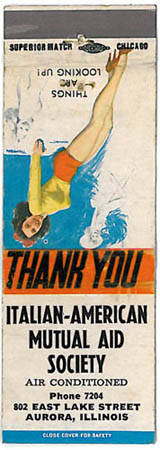My Italian American Museum
For several years now I have been buying objects on eBay.com associated with Italian-American history and culture. My purchases are somewhat eclectic and my collection is by all definitions a mixed bag. I select objects relating to my research interests (a recording by Phil Brito, a religious banner, an embroidered commemorative) and my personal aesthetics (a match book cover, a 1955 cookbook). Getting a bargain and beating the bidding competition adds to the objects’ appeal.
I’ve also obtained a slew of photographs simply because I liked them: a mustachioed man outfitted in festa regalia; an Italian boy in a fascist uniform; a middle-aged woman with a Mona Lisa smile. I find these images beautiful in their own right. I imagine them on a book cover or as an illustration for a future article.
But for every stunning photograph, I’ve also had to purchase numerous mundane snapshots and formal portraits of limited aesthetic worth as part of a cache of images up for bid. I’ve given them away or quietly discarded them.
Few of these photographs come with any contextual information and when they do it is minimal at best, e.g., “Italian Americans from Chicago and Phoenix” or “family of S. Corsale, a barber in NYC and Phillipsburg, NJ, 1910s-40s.” The people depicted are the anonymous faces from history’s jetsam. Ultimately, these photographs pose challenging questions concerning collecting and ultimately the role of museums.
Objects speak to us, they tell us stories, but those narratives are not always apparent. It is we who derive the tale that an object tells. We give it voice, making it speak in an act of interpretative ventriloquism. And doing so is hard work.
It is one thing for an individual to accumulate objects but quite another when a museum does so. Such institutions have a responsibility not merely to collect artifacts but to enter into a conversation with them on behalf of museum-goers and the historical record. That work involves curators, scholars, and other professionals knowledgeable in the area of interest and, more importantly, museum work itself.
After the Calandra Institute’s 1999-2000 exhibition, “The Italians of New York,” curated by historian Philip Cannistraro at the New-York Historical Society, I was charged with soliciting people to donate the approximately 360 objects they had originally lent. The Calandra Institute did not have the staff skilled in collections management and archival processing so I successfully wrote a grant to have archivist Nancy Johnson consult with the Institute to develop a strategic plan for the archives. Her final report concluded that “formally accessioning and documenting the Calandra collection is a priority.” This recommendation involved interviewing the objects’ former owners so as to create the narrative the individual artifacts could tell future generations. The Institute’s director at the time, Joseph Scelsa, dismissed the consultant’s conclusions and ultimately ignored them.
In agreement with the City University of New York, the hundreds of objects collected by the Calandra Institute became the property of New York City’s Italian American Museum, an entity incubated at the Institute where it mounted its first exhibitions. (I curated three of those exhibits as part of my responsibilities at the Calandra; see the list below.)
I have yet to visit the museum—or the five other Italian-American museums in the country (see the list below)—but a recent newspaper article states that the institution has “a frankly hodge-podge cast to the exhibits.” That is a discouraging assessment. One can not help but wonder if the objects have been encouraged to speak. If so, are their voices strong, clear, and annunciated—or a faint, garbled mummer? Is there anyone there who is receptive to truly listening and properly equipped to engage in dynamic conversation with objects?






































i-Italy
Facebook
Google+
This work may not be reproduced, in whole or in part, without prior written permission.
Questo lavoro non può essere riprodotto, in tutto o in parte, senza permesso scritto.